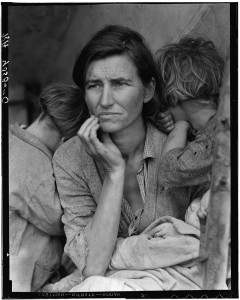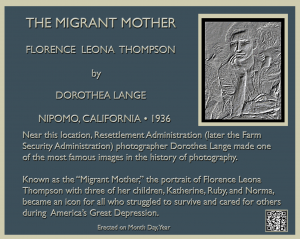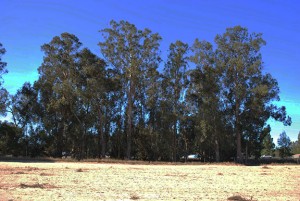Dorothea Lange
Dorothea Lange was a woman intent on changing the world through her photographs. Lange said, “Art is an act of total attention.”

Destitute pea pickers in California. Mother of seven children. Age thirty-two. Nipomo, California
Digital ID: (digital file from original neg.) fsa 8b29516 http://hdl.loc.gov/loc.pnp/fsa.8b29516
Reproduction Number: LC-DIG-fsa-8b29516 (digital file from original neg.) LC-DIG-ppmsca-12883 (digital file from print, pre-conservation) LC-DIG-ppmsca-23845 (digital file from print, post-conservation) LC-USF34-T01-009058-C (b&w film dup. neg.) LC-USZ62-95653 (b&w film copy neg. of an unretouched file, showing thumb)
Repository: Library of Congress Prints and Photographs Division Washington, DC 20540 http://hdl.loc.gov/loc.pnp/pp.print
Lange made perhaps the most famous picture from the Farm Security Administration documentary headed by Roy Stryker. The picture showed Florence Thompson with two of her children over her shoulders. Lange had passed the camp where Thompson lived in a tent but turned her car around to visit the camp. That turn in the road led to one of the most iconic pictures in the history of photography–”Migrant Mother.”
Lange described the picture in a Popular Photography article:
“I saw and approached the hungry and desperate mother, as if drawn by a magnet. I do not remember how I explained my presence or my camera to her, but I do remember she asked me no questions. I made five exposures, working closer and closer from the same direction. I did not ask her name or her history. She told me her age, that she was thirty-two. She said that they had been living on frozen vegetables from the surrounding fields, and birds that the children killed. She had just sold the tires from her car to buy food. There she sat in that lean- to tent with her children huddled around her, and seemed to know that my pictures might help her, and so she helped me. There was a sort of equality about it.” (From: Popular Photography, Feb. 1960).
Click on the picture to see it in a larger size. Thompson was 32 years of age when the picture was made.
See more pictures made at the same time.
My friend Paul Lester, Ph.D., developed a project to establish a historic marker near the site where Lange’s famous picture was made. Dr. Lester describes the project.
The Migrant Marker Project (click on the photographs to see them in a larger size)

Draft concept for the historic marker. The QR code in the lower right corner will take readers to the location of Lange’s photographs in the Library of Congress.
One day in April 2012, my wife and I drove from San Francisco back to our home in the southern part of the state. Wanting a more scenic route, we took Hwy 101 rather than Interstate 5. As we passed the small town of Nipomo, about 25 miles south of San Luis Obispo, it occurred to me that there was no historical marker commemorating the fact that one of the most famous photographs, “The Migrant Mother,” was taken by Dorothea Lange in the area. After I arrived home, I started contacting those I thought would be interested in joining the Migrant Marker Project. There are now about 60 persons on my email list.
Since that inspiring journey, I have learned through my own research and the assistance of many experts, several facts about the pictures Lange took of Florence Thompson and her children. For example, despite Lange saying in an interview that she made five exposures of the family, there were actually seven photographs taken, the automobile that broke down is not seen in the pictures because Florence was moved to another location to await her partner and sons to return, and, more importantly, the location the picture was taken has been found. Richard Hillery, who read about my efforts in the local newspaper, set up a geocache site at http://www.geocaching.com/seek/cache_details.aspx?guid=94ce606e-58dd-4aef-83f9-b881e64022e6
Currently, a landscape architect working for the Olde Towne Nipomo Association produced a preliminary drawing of the J. O. Miller Park Plan, where the Migrant Marker will be erected. The location of the park in Nipomo is near W. Tefft, Carrillo, and W. Dana streets. After final approval, the marker will be erected and Thompson and Lange will be linked again through the tribute to both women.
If you wish to make a tax deductible contribution toward the completion of the historic marker, the National Press Photographers Foundation is receiving contributions.


